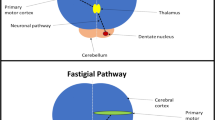Abstract
Rationale
Valproate is widely used in the treatment of epilepsy, bipolar disorder, and chronic pain disorders, but its exact mechanisms of action is still incompletely understood.
Objectives
Here we used transcranial magnetic stimulation to explore effects of a single dose of 800 mg valproate on motor cortex excitability in healthy volunteers.
Methods
Motor threshold, peripheral maximum M-wave, cortical silent period short intracortical inhibition, intracortical facilitation, and motor evoked potential recruitment were assessed before and 1.5 h after the administration of valproate in 15 (eight male, seven female) healthy volunteers.
Results
None of the measures of cortical excitability were found to be altered significantly after valproate.
Conclusion
These results are in line with previous findings of unaffected intracortical excitability after a single dose of valproate, suggesting that valproate’s immediate in vivo actions do not resemble the effects of classic GABAergic compounds.
Similar content being viewed by others
References
Faul F, Erdfelder E, Lang A, Buchner A (2007) G*Power 3: a flexible statistical power analysis program for the social, behavioral, and biomedical sciences. Behav Res Meth 39(2):175–191
Johannessen CU (2000) Mechanisms of action of valproate: a commentatory. Neurochem Int 37(2–3):103–110
Johannessen CU, Johannessen SI (2003) Valproate: past, present, and future. CNS Drug Rev 9(2):199–216
Kapogiannis D, Wassermann EM (2008) Transcranial magnetic stimulation in clinical pharmacology. Cent Nerv Syst Agents Med Chem 8(4):234–240
Kujirai T, Caramia MD, Rothwell JC, Day BL, Thompson PD, Ferbert A et al (1993) Corticocortical inhibition in human motor cortex. J Phys 471:501–519
Langguth B, Bauer E, Feix S, Landgrebe M, Binder H, Sand P et al (2007) Modulation of human motor cortex excitability by the cholinesterase inhibitor rivastigmine. Neurosci Lett 415(1):40–44
Langguth B, Eichhammer P, Spranz C, Landgrebe M, Frick U, Sand P et al (2008) Modulation of human motor cortex excitability by quetiapine. Psychopharmacology 196(4):623–629
Li X, Ricci R, Large CH, Anderson B, Nahas Z, George MS et al (2009) Lamotrigine and valproic acid have different effects on motorcortical neuronal excitability. J Neural Transm 116(4):423–429
O’Keefe D (2007) Post hoc power, observed power, a priori power, retrospective power, prospective power, achieved power: sorting out appropriate uses of statistical power analyses. Commun Meth Measures 1(4):291–299
Reis J, Tergau F, Hamer HM, Müller H, Knake S, Fritsch B et al (2002) Topiramate selectively decreases intracortical excitability in human motor cortex. Epilepsia 43(10):1149–1156
Rho JM, Sankar R (1999) The pharmacologic basis of antiepileptic drug action. Epilepsia 40(11):1471–1483
Rizzo V, Quartarone A, Bagnato S, Battaglia F, Majorana G, Girlanda P (2001) Modification of cortical excitability induced by gabapentin: a study by transcranial magnetic stimulation. Neurol Sci 22(3):229–232
Rosenberg G (2007) The mechanisms of action of valproate in neuropsychiatric disorders: can we see the forest for the trees? Cell Mol Life Sci 64(16):2090–2103
Rossini PM, Barker AT, Berardelli A, Caramia MD, Caruso G, Cracco RQ et al (1994) Non-invasive electrical and magnetic stimulation of the brain, spinal cord and roots: basic principles and procedures for routine clinical application. Report of an IFCN committee. Electroencephalogr Clin Neurophysiol 91(2):79–92
Sohn YH, Kaelin-Lang a, Jung HY, Hallett M (2001) Effect of levetiracetam on human corticospinal excitability. Neurology 57(5):858–863
Thomas L (1997) Retrospective power analysis. Conserv Biol 11(1):276–280
Werhahn KJ, Kunesch E, Noachtar S, Benecke R, Classen J (1999) Differential effects on motorcortical inhibition induced by blockade of GABA uptake in humans. J Phys 517(2):591–597
Ziemann U (2004) TMS and drugs. Clin Neurophysiol 115(8):1717–1729
Ziemann U, Lönnecker S, Steinhoff BJ, Paulus W (1996) Effects of antiepileptic drugs on motor cortex excitability in humans: a transcranial magnetic stimulation study. Ann Neurol 40(3):367–378
Ziemann U, Lönnecker S, Steinhoff BJ, Paulus W (1999) Motor excitability changes under antiepileptic drugs. Adv Neurol 81:291–298
Acknowledgments
The authors wish to thank Sandra Pfluegl and Helene Niebling for technical assistance.
Matthias Zunhammer has been supported by the Elite Network Bavaria.
Disclosures
None of the authors has any conflict of interest to disclose.
Author information
Authors and Affiliations
Corresponding author
Rights and permissions
About this article
Cite this article
Zunhammer, M., Langguth, B., Landgrebe, M. et al. Modulation of human motor cortex excitability by valproate. Psychopharmacology 215, 277–280 (2011). https://doi.org/10.1007/s00213-010-2126-y
Received:
Accepted:
Published:
Issue Date:
DOI: https://doi.org/10.1007/s00213-010-2126-y




